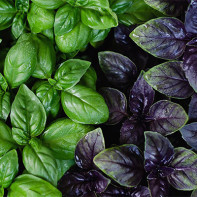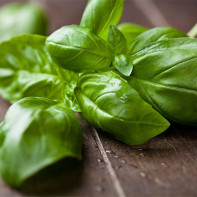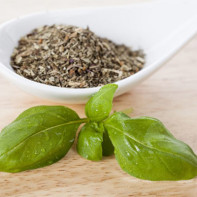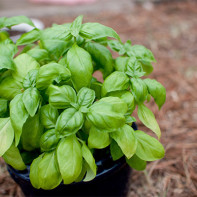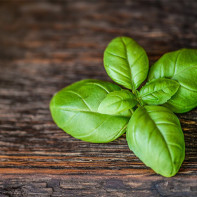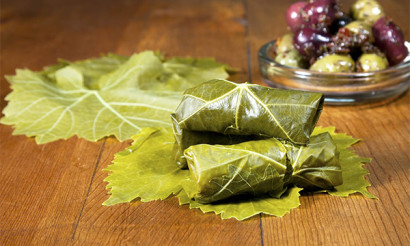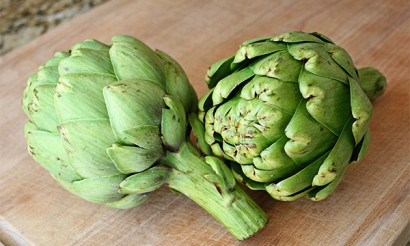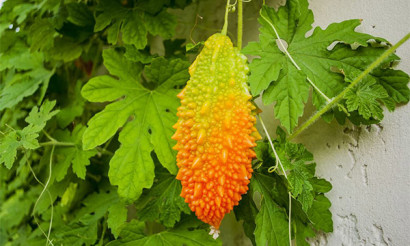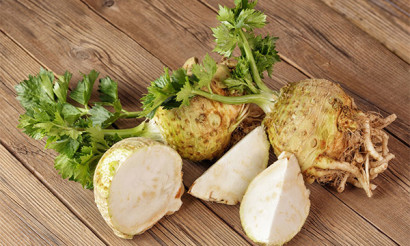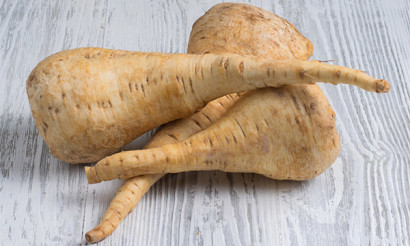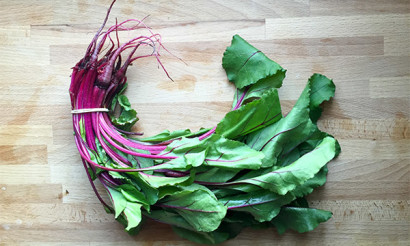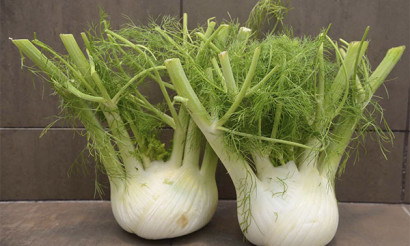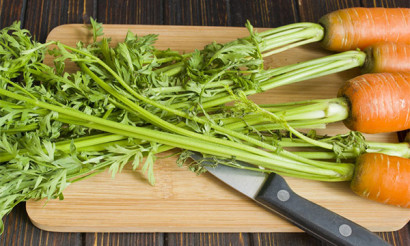Basil: health benefits and harms
Basil is a spicy aromatic culture popular in many countries of the world, which is very useful for the human body.
- What is basil and how does it look
- Kinds
- Which basil is healthier: green or purple
- Composition and calorie content
- Useful properties of basil
- General benefit
- For women
- During pregnancy
- When breastfeeding
- For kids
- When losing weight
- Benefits of Tea with Basil
- What is the use of dried basil
- Basil in medicine
- With diabetes
- With pancreatitis
- With gastritis
- With gout
- Traditional medicine recipes with basil
- Basil in cosmetology
- For face
- For hair
- The use of basil in cooking
- Harm and contraindications
- How to store basil
- Is it possible to freeze
- How to dry
- Basil essential oil: properties and applications
- Basil drink with lemon
- How to grow basil on a windowsill
- Interesting facts about the basilica
What is basil and how does it look
Basil is a plant with a branched upper part that grows in South Asia. It has a tetrahedral stem, the average height of which is 45 cm. The leaves have an elongated shape, green or purple, with notches along the edge. On small inflorescences in the form of tassels, flowers are located that have a light pinkish or violet-white color.
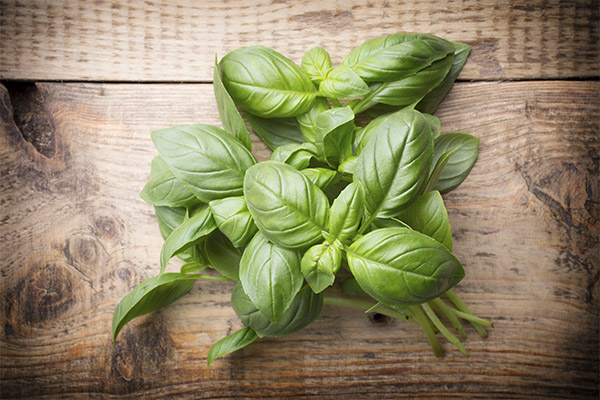
Basil leaves are perfect for meat, fish and vegetables. It can be used as seasoning - this will give the dish a pleasant aroma. Basil has a sweet taste with bitterness. Spice can also be used in winter harvesting.
Kinds
There are quite a few different types of basil (about 70). They differ in the height of the bushes, the color and shape of the leaves.
- Fragrant. The plant has many leaves and a height of about 60 cm. Leaves and stems are characterized by pepper aroma.
- Purple. Bush height to half a meter. The color of the leaves is bright purple. It has a pronounced aroma.
- Green. Plants have light green leaves, the average height of the bushes is 40 cm. The aroma is not as saturated as that of the purple species.
- Cinnamon. The height of the plant is about half a meter. Leaves have a bright green color. A slightly minty aroma and a burning aftertaste.
- Citric. The height of the bush is up to 35 cm, the leaves have a pale green color. Lemon flavor.
- The black. Leaves and stems have a dark or black-purple color. The height of the bushes is on average about 40-60. Strong peppery, slightly burning aroma.
Which basil is healthier: green or purple
If you compare the beneficial properties of purple and green basil, then they are not particularly different. Both types help to effectively cleanse the body, can be used as medications for various inflammation and gastrointestinal problems.
Composition and calorie content
In 100 grams of product:
- calories - 23 kcal;
- proteins - 3.2 g;
- fats - 0.6 g;
- carbohydrates - 1.1 g;
- fiber - 1.6 g;
- water - 92.06 g.
The basil also contains vitamins A, B3, B4, B9, C, E, K. Spice is rich in potassium, calcium, magnesium, sodium and phosphorus, as well as iron, manganese, copper and zinc.
Useful properties of basil

General benefit
- The basil contains substances that help fight inflammation in the body, and also have a calming effect on it. Basil helps reduce swelling.
- The cure for arthritis. Joint diseases provoke swelling and pain. Sometimes this can even lead to damage to the heart, eyes, lungs and kidneys. The basil contains a large amount of beta-caryophyllene. A study at the Swiss Federal Institute of Technology found that beta-caryophyllene helps tolerate arthritis and can even treat it.
- The plant contains essential oils that help protect the body from bacteria and germs. Pathogenic bacteria cause various diseases: acute pharyngitis, cholera, tuberculosis and food poisoning.The substances contained in the basil are able to prevent the spread of bacteria by inhibiting their growth and reproduction.
- Rich in antioxidants that help regulate the amount of free radicals in the body. Free radicals can cause oxidative stress, which negatively affects proteins and genes. Antioxidants neutralize free radicals and repair damaged cells. Due to its high content of vitamin C, basil is able to effectively combat oxidative stress in the body.
- The substances contained in the basil help in the fight against the spread of malignant cells. They also help protect healthy cells during chemotherapy. Therefore, basil is useful as a prophylactic against cancer, and also helps to support the body during treatment.
- Helps treat diabetes. Basil lowers bad cholesterol and triglycerides. Bad cholesterol can trigger diabetes. Some studies have shown that basil can be used to treat and prevent this disease.
- Basil supports functions that help protect the liver. The plant contributes to a significant increase in the production of detoxifying enzymes and reduces the accumulation of fat.
- Basil leaves can significantly reduce stress. They help protect the respiratory system and the cardiovascular system, help lower blood sugar levels and prevent oxidative stress.
- One of the effects of oxidative stress is premature aging. Basil helps maintain youthfulness and health. Free radicals have a very negative effect on the skin, and exposure to ultraviolet rays can trigger the appearance of dark spots. Basil contains antioxidants that are able to actively combat the above effects.
- Useful for bones. With age, bone tissue loses its density, bones become fragile, so the likelihood of fractures increases. Basil is a great source of vitamin K, which helps maintain bone density.
- Supports metabolism. Manganese contained in the basil is involved in the metabolism. It supports enzymes that help in the metabolism of cholesterol, amino acids and carbohydrates. In addition, it is necessary for the metabolism of several glucose-related vitamins, including B1 and E. Also, the copper contained in the plant helps the various enzymes that take part in metabolic processes to function properly.
- Can prevent epilepsy - a chronic neurological disease characterized by relapses of unprovoked seizures. Seizures can affect health and even safety, especially if this occurs while driving or working with dangerous objects (such as a knife). One of the triggers of epileptic seizures is a low level of manganese. Basil has a high content of manganese, and its regular use can prevent attacks.
For women
Basil is useful for women: it does not contain very many calories, it contains no cholesterol, and it also helps to accelerate the breakdown of fats, so the spice is perfect as a dietary product. Plant-based decoctions help reduce pain during menstruation, restore the cycle and enhance lactation during breastfeeding. The essential oils contained in the plant are very actively used in the field of cosmetology, and also help eliminate brittle hair and nails.
During pregnancy
Useful properties of basil during pregnancy:
- The essential oils contained in the plant, as well as vitamin C and volatile, help the immune system protect the body against infections. During pregnancy, this is very important, since even a small cold can cause significant harm to the expectant mother and baby.
- Basil helps with headaches, so instead of drugs, the intake of which is significantly limited, you can use this spice.
- Iron and folic acid support the development of the fetus, and also help prevent the occurrence of anemia in a pregnant woman.
- Thanks to potassium in the composition of the basil, the regular use of spices helps to avoid seizures.
In addition, basil helps to calm, normalizes the heart muscle, has wound healing properties and can be used for fungal infections.
In addition to the benefits, basil can also harm a pregnant woman. With excessive consumption of spices, the threat of abortion increases. The reaction to essential oils in people is different, so various symptoms may occur:
- itching and rash;
- irritation of the mucous membrane of the esophagus;
- stomach upset.
Women who have had such symptoms before pregnancy should exclude basil from their diet.
When breastfeeding
Basil is one of the best representatives of the plant world that are able to fight anemia, so it is very useful for women in the postpartum period. It also helps to improve digestion and helps in the functioning of the nervous system, has calming properties, supports the body during times of stress.
You can enter basil in the diet after 2 months after giving birth. In case of diabetes mellitus or problems with the cardiovascular system, this spice is not recommended.
For kids
The essential oils contained in the basil help to strengthen the immune system, as they have antimicrobial properties. Leaves should be included in the raw diet of children, since in the processed they, as a rule, have less beneficial properties. Eugenol and estragol present in essential oils stimulate brain activity, especially in children.
Basil is allowed to be included in the children's diet, but only from 5 years old.
When losing weight
Nutritionists say that basil can be safely included in the diet. Shredded leaves can be added to the salad or put on a sandwich.
It is not recommended to eat the product in its pure form and especially should not exceed the norm of consumption. It is allowed to eat up to 30 g of greens per day and only as part of dishes (not in kind).
Since it is a distant relative of peppermint, its branches can be brewed as tea. It is recommended to regularly use teas and other drinks based on basil, as they carry, although small, but still benefit during the weight loss period. The daily norm of consumption of drinks based on basil seeds is up to 400 ml. For maximum effect, you should drink 100 ml 30 minutes after eating. The drink should not be taken before meals, as it can provoke an increase in appetite. The duration of regular use of basil should not exceed 20 days. After 30–35 days, basil can again be included in the diet.
Benefits of Tea with Basil
Tea with basil is a healthy relaxing drink based on the leaves of this plant. It has a large number of useful and even healing properties.
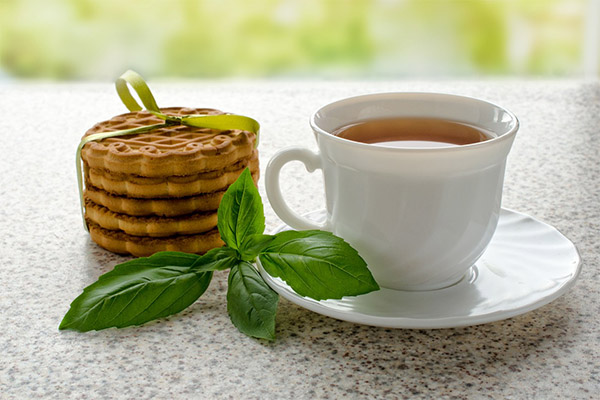
- Helps strengthen immunity. Tea with basil stimulates the protective functions of the body, so the drink helps to strengthen the immune system and supports the body in the fight against infections.It is recommended to use basil tea, as this will help prevent the development of infections and increase the body's resistance.
- Prevents the development of cancer. Tea with basil can also help prevent cell damage from free radical activity. The antioxidants contained in tea help prevent the development of chromosomal defects, which in turn reduces the likelihood of cellular mutations leading to the growth and development of tumors.
- Reduces inflammation. Tea with basil contains a large number of different essential oils, which can inhibit enzymes that provoke inflammation in the body. Although this is the body’s normal response to the effects of infection, chronic inflammation can cause many long-term disorders in the body, such as rheumatoid arthritis, heart disease, and diabetes. Therefore, in order to avoid the undesirable consequences of inflammation, it is recommended to use tea with basil.
- Detoxification. Studies conducted in rodents showed that those who received basil extract for only 5 days had the production of more detoxifying enzymes, unlike those in which the body did not get basil.
- Natural aphrodisiac. For many centuries, basil leaves and tea based on them were used as a natural aphrodisiac. People believed that the drink improves blood flow in the pelvic area. Today, science has confirmed these assumptions, and also found that basil tea reduces stress and inflammation, which directly affects the health of the reproductive system and the production of testosterone.
- Supports cardiovascular health. Tea with basil helps to strengthen the health of the entire cardiovascular system, has an anti-inflammatory effect, which helps prevent platelet aggregation and the likelihood of blood clots, reducing the risk of strokes and heart attacks. In addition to this, tea helps thin the blood and reduces cholesterol deposits on the walls of blood vessels, which can adversely affect the blood circulation.
- Helps fight depression. It is known that regular consumption of tea with basil helps to improve mood. This is due to its ability to stimulate the synthesis of neurotransmitters that enhance mood, such as dopamine and serotonin. These neurotransmitters have a positive effect on brain health in general.
What is the use of dried basil
Dried basil has anti-inflammatory properties and helps prevent migraines and asthma attacks. Oncologists recommend regular use of this spice, since basil is a warning against tumors. It helps to cleanse the body of carcinogens that provoke oncology. According to some experts, dried basil can protect against radiation.
Basil in medicine
Basil is also widely used in medicine. It helps to strengthen the immune system, and is also especially effective as a means of protection against infections. Preparations based on basil help with problems with the respiratory tract, circulatory system, as well as inflammation of the kidneys.

With diabetes
Basil has a fairly low glycemic index (5 units). It contains vitamins C, PP, B1, as well as rutin and carotene. Spice helps to strengthen the walls of blood vessels and improve the state of the nervous system. In addition, basil supports the production of insulin. It is recommended to chew basil leaves in the morning on an empty stomach, and it can also be used in salads, sauces, soups, with fish and meat.Do not use basil for diabetes in pregnant and lactating women.
With pancreatitis
You can use basil for pancreatitis, but only during the period of remission. The plant supports the work of the digestive tract, has antimicrobial properties, promotes the activation of the production of gastric enzymes. The basil contains a large amount of essential oils, so the recommended daily intake is up to 2 teaspoons of chopped leaves.
With gastritis
Basil for gastritis is not a prohibited product, but rather, even recommended during the period of remission. Moreover, it is often used as a tool to help get rid of the symptoms of this ailment. For example, basil-based drinks help suppress heartburn.
With gout
Basil is also useful for gout. The oils contained in the plant help to reduce the level of uric acid in the blood, this helps a person to feel better. These oils also help suppress pain in an acute attack of gout.
Traditional medicine recipes with basil
Cough infusion
- Pour flowers or basil leaves (20 g) with boiled water (1 glass) and put in a water bath (for 15 minutes).
- Remove from the bath and let cool (45-50 min).
- Strain the infusion.
- Take 70 ml every day half an hour before meals.
A decoction from the common cold
- Pour boiled water (1 glass) into the seeds or aerial parts of basil (15 g) and put in a water bath (for 30 minutes).
- Cool (10 minutes) and strain with gauze.
- Take 3 times a day, 70 ml before meals.
Bath with basil
The grass is brewed (4 tbsp) with boiling water (1 l), infused, filtered and poured into the bath. It is taken at temperatures up to + 38ºC for about 20 minutes. Helps to relax, get rid of skin diseases.
Basil in cosmetology
Basil is widely used in cosmetology. There are many different masks for skin and hair based on basil, which help rejuvenate and improve the appearance.
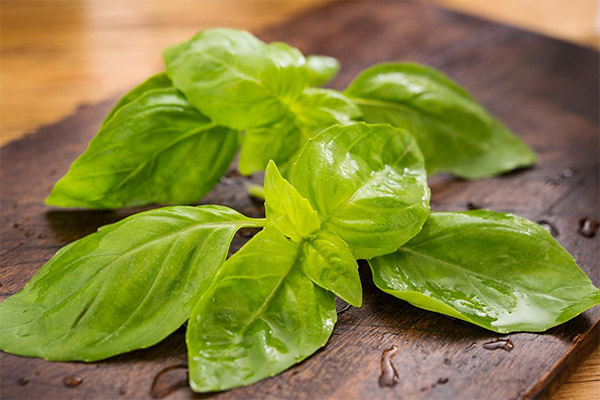
For face
Mask for skin tightening
- Grind basil leaves to a state of gruel.
- Apply mass on face, neck and décolleté.
- Put gauze on the selected area.
- Action time - 30 minutes.
- Wash with cool water.
Mask from black dots
- Moisten the leaves in water and place them in the area with black dots.
- Action time - 5 minutes.
- Wash with cool water.
Face lotion
- Grind basil leaves to a state of gruel.
- Pour the resulting mass with boiling water (1 cup) and leave for 30 minutes.
- Filter and wipe skin regularly.
For hair
Broth against hair loss
- Chopped fresh leaves (2 tablespoons) steamed in boiling water (up to half a liter) and let it brew for 30 minutes.
- Strain the infusion.
- Wash their hair after using shampoo.
Dry hair mask
- Dry basil (1 tablespoon) and rosemary (1 tablespoon) pour boiling water (1 liter), add coconut oil (1 tablespoon).
- Add lemon essential oil (2 drops) and let it brew for 30 minutes.
- Apply to the scalp (rubbing into the roots) and wrap hair with a towel.
- Action time - 30 minutes.
- Wash off the mask with water.
The use of basil in cooking
The properties possessed by basil are highly regarded in the field of culinary, as it gives the dishes benefits and a spicy spicy taste with a touch of bitterness. Basil can be used both in natural and dried form. With proper storage, the plant may not lose its beneficial properties for a very long time. As a rule, when cooking, parts of the plant that are on the surface of the soil are used.
Fresh basil is considered especially valuable. Fresh young leaves and shoots in crushed form can be seen in various salads, sandwich variations, marinades, pickles, as well as in the composition of vegetable, meat and fish dishes. Basil is also very common in ketchups, gravy and salad dressings. Basil is an indispensable product during canning and smoking. Sprigs of the plant are used to add flavor to various dishes.
What can be replaced
It’s quite difficult for a basil to pick a replacement. But in a completely hopeless situation, it can be partially replaced with oregano, thyme and marjoram.
Harm and contraindications
People who have low blood sugar levels, as well as those who have low blood pressure, are not recommended to use basil, as this spice can aggravate the condition.
With a very long and intensive consumption of basil, the likelihood of developing liver cancer increases due to the presence of estragol in the plant. For the same reason, a large amount of basil may be unsafe for pregnant, breastfeeding women or small children.
How to store basil
There are several ways to store basil:
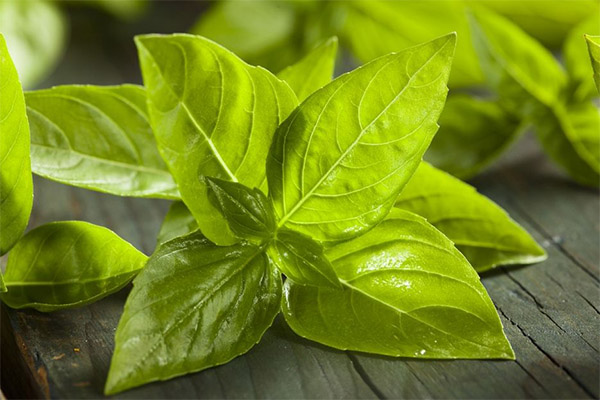
- Basil pre-wrapped in plastic wrap can be refrigerated. This will help him stay fresh longer.
- Trim the stems and place the basil in water (can be refrigerated). This will also help to increase the shelf life (up to 7–8 days).
Is it possible to freeze
Basil can be frozen. It must be washed and dried. After that, wrap in a plastic bag and place in the freezer. This will keep the spice for quite some time.
How to dry
Basil can also be dried. First you need to wash it and wait until it dries. After this, it is necessary to suspend the plants with their leaves down in a ventilated, dry and dark place.
Basil essential oil: properties and applications
Basil oil is obtained by distillation of a couple of leaves of the plant. The resulting product has many useful and healing properties.
- Helps increase body tone and stimulates defenses to more active work.
- It also helps regulate blood pressure, which prevents dizziness, migraines and headaches.
- Basil oil has strong properties that regulate digestion and help relieve discomfort in case of overeating.
- Helps relieve symptoms of respiratory and colds.
- Basil oil also has an activating effect in case of irregular menstruation.
Application
In the field of cosmetology, basil oil is used as a skin and hair care product. Oil helps to eliminate almost any problems associated with the health and appearance of the skin. The only thing she cannot fight with is warts.
Oil helps stimulate hair growth, improves its structure and gives a healthy shine. Essential oil is also used in dentistry as a remedy for lesions of the oral cavity and in the event of ulcers on the gums. Oil can act as an assistant in the fight against insects and helps to eliminate the consequences of their bites. In cooking, basil oil is used for preservation, and is also great for meat dishes.
Basil drink with lemon
Ingredients:
- water - 1.5 l;
- basil (purple) - 50 g;
- lemon - 1 pc.;
- sugar - 100 g.
- Place the washed basil in a jug-like container and pour boiling water into it. Leave on for 20 minutes until the color of the water turns dark purple.
- Squeezed out and filtered lemon juice pour into a container.
- After that add sugar and stir well.
To get an even more healthy drink, you can add grated ginger root.
How to grow basil on a windowsill
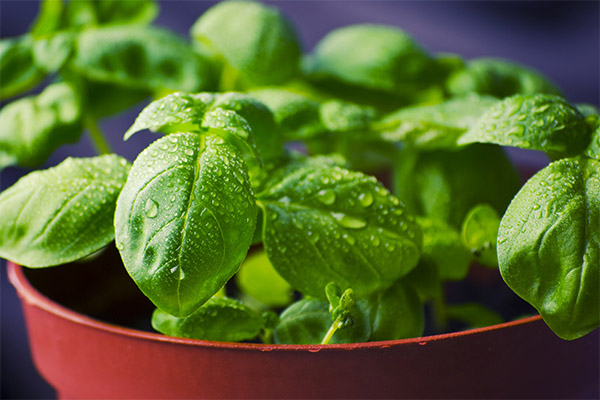
- The first thing to do is prepare the soil for planting. It is recommended to use land and peat in a ratio of 1: 1 (or take universal ready-made soil).
- It is possible to sow basil both with picking and without it. If you decide not to dive, then you should first grow seedlings, and only after transplanting it into boxes.
- Seeds must be sown in harvested containers. The interval between rows is 5 cm, the planting depth is 0.5 cm. After planting, sprinkle with earth, moisten and cover with a film.
- Seedlings need to be placed in a warm room. After 9-12 days, the first shoots will appear. After that, you need to remove the film and move the boxes to a place with access to the sun. Pour basil with warm water, while it is important not to pour.
- The first feeding is carried out on the 10th day after the emergence of shoots. After 3 weeks, plants can be dived into pots.
- After a week, you need to re-feed. This must be done very carefully so as not to harm the plants.
- After 3 weeks, when the shoots have already grown to 10–13 cm, it is allowed to break off the grown leaves. It is recommended to feed the plants after harvesting.
- With the advent of 5-6 leaves, those leaves that are on top must be pinched off.
- Watering should be done in the morning, 1 time in 4 days.
- Plants are recommended to be placed in the sunniest place or to arrange illumination for it.
Interesting facts about the basilica
- Basil is universal. It can be used both fresh and dry. It can be used in both savory and sweet dishes.
- In folk medicine, basil is widely used. Tea with basil is very useful, it is used to treat a wide range of diseases: from constipation and stomach cramps to anxiety and depression.
- Basil contains chemicals that insects do not like (while not harmful to humans). For example, mosquitoes do not like basil.
- Basil is revered in various religions. In addition to the fact that the Indians consider the plant sacred, in some countries (for example, Bulgaria, Slovenia, Macedonia and Serbia) it is used in the preparation of holy water.
- Basil has kinship with mint.
«Important: all information on the site is provided exclusively in fact-finding purposes. Before applying any recommendations, consult with a profile specialist. Neither the editors nor the authors are liable for any possible harm caused materials. "


